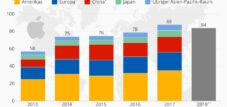Apple is investing $ 500 billion in the USA-impact on production and logistics
Xpert pre-release
Language selection 📢
Published on: March 1, 2025 / update from: March 1, 2025 - Author: Konrad Wolfenstein
Apple is changing its production so massively: the 500 billion dollar investment and its global consequences
Job boom in the USA? Apple creates 20,000 new jobs-this is behind the mega investment!
In a sensational announcement that worked like a bang in the global economic world, the technology giant Apple has announced an investment of an incredible $ 500 billion in the United States. This gigantic sum, which is to flow over the next four years, is not only a sign of trust in the US's business location, but also a strategic move of immense scope. The announcement was made in the midst of geopolitical tensions and an increasing debate about the resilience of global supply chains. It throws a new light on Apple's production strategy, its relationships with the USA and the future orientation of the global technology industry.
This investment is more than just a financial promise; It is a comprehensive program that aims to fundamentally change and strengthen Apple's presence in the USA. The focus is on the creation of 20,000 highly qualified workplaces, the construction of a state-of-the-art state of AI server in Texas, the doubling of a billion-dollar fund to promote chip production and the establishment of an academy to strengthen small companies. These measures are not only important for Apple itself, but also have the potential to sustainably influence the US economy and to redesign global supply chains.
The background of this decision are complex and range from political considerations to long -term strategic goals. While some observers see the investment in response to protectionist tendencies and trade conflicts, others at Apple's wish to diversify their supply chains, to be closer to important sales markets and to benefit from the USA's innovative strength. Regardless of the exact motifs, it is clear that this investment is a turning point for Apple and possibly for the entire global technology industry.
In this comprehensive article we examine the central aspects of Apple's 500 billion dollar investment in detail. We analyze the strategic goals, the potential effects on production and logistics, the changes in the global supply chains and the challenges and opportunities that result in Apple and the US economy. In addition, we take a look at the long -term consequences of this decision and its importance for the future orientation of the global technology industry. Accompany us on an exciting journey through the world of high technology, global economy and strategic corporate decisions to understand the full scope of Apple's billion dollar investment.
Suitable for:
- Automated high-bay warehouses and pallet warehouses in the USA: Market development and innovations in logistics and intralogistics
Apple's billion dollar investment in the USA: a strategic move with far -reaching consequences for production, logistics and the global economy
The announcement of the technology-giant Apple, to invest an impressive sum of $ 500 billion in the United States in the next four years, has caused a sensation in business circles worldwide. This massive capital commitment, which became public shortly after a meeting between Apple CEO Tim Cook and the then US President Donald Trump, not only signals a strong commitment to the USA's business location, but also highlights the changing global dynamics in production and trade.
This investment offensive is unprecedented and exceeds earlier announcements from Apple. It is a multi -layered project that goes far beyond mere financial commitments and will have profound effects on different areas. In order to fully record the scope of this decision, it is important to take a closer look at the central points of the investment and to analyze their potential consequences for Apple, the US economy and global supply chains.
The pillars of the 500 billion dollar investment: a detailed look
Apple's investment plan rests on several pillars that are strategically coordinated and address various aspects of corporate growth and economic development in the USA:
1. Creation of 20,000 new, highly qualified workplaces
A core component of the investment is the creation of 20,000 new jobs in the United States. These areas will focus primarily on promising areas such as research and development, software development, artificial intelligence (AI) and machine learning (ML). This orientation underlines Apple's strategic focus on innovation and the development of top technologies. These are not simple production jobs, but highly qualified positions that are intended to strengthen the intellectual capital and the innovative strength of the United States. The distribution of these jobs is expected to extend across different locations in the USA, whereby centers such as California, Texas and possibly other technology hubs will focus. The creation of these jobs not only has direct positive effects on the employment situation, but also indirect effects by boosting the local economy, increasing purchasing power and promoting innovations in related industries.
2. Construction of a state-of-the-art factory in Houston, Texas, for AI server
A particularly important part of the investment is to build a new factory in Houston, Texas. This production facility should specialize in the production of AI-capable servers that will play a central role for “Apple Intelligence”. The choice of Houston as a location is strategically wise. Texas has developed into an important technology center in recent years, benefits from a company -friendly policy, lower living costs compared to California and a growing number of qualified specialists. The production of AI servers in the USA is a clear signal that Apple wants to settle critical infrastructure and key technologies more in their own country. AI servers are the backbone of modern data-driven applications and services, and their local production strengthens technological sovereignty and resilience. The size of the planned factory and the exact production capacities have not been announced publicly, but it can be assumed that it will be a significant investment in a state -of -the -art production facility that is up to date with the latest technology.
3. Duplication of the “US Advanced Manufacturing Fund” to promote chip production
Apple has announced that the “US Advanced Manufacturing Fund” to double $ 10 billion. This fund was launched to promote and support innovative manufacturing processes in the USA. The focus is particularly on chip production in Arizona. The semiconductor industry is of strategic importance for the entire modern economy, and the global dependence on few chip manufacturers, especially in Asia, has increasingly worried in recent years. The doubling of the fund and the targeted promotion of chip production in Arizona are an important step to strengthen the domestic semiconductor industry and reduce the dependency on foreign supply chains. Arizona has developed into an important center for semiconductor production in the United States, and companies such as TSMC (Taiwan Semiconductor Manufacturing Company) are investing massively in new factories in this state. Apple's commitment in this area is a strong signal for the importance of the semiconductor industry and the need to expand the production capacities in the USA.
4. Foundation of a “Manufacturing Academy” in Detroit to strengthen small and medium -sized enterprises (SMEs)
Detroit, the former “Motor City” of the USA, is to become the location of a new “Manufacturing Academy”. This academy aims to support and promote smaller and medium -sized companies (SMEs) in the area of production. Detroit has gone through a structural change in recent decades and is looking for new ways to diversify its economy and create new jobs. The “Manufacturing Academy” could play an important role in the revitalization of the local manufacturing sector by providing SMEs access to training, resources and networks. The exact details of the academy, such as the programs offered and the target groups, have not yet been fully announced. However, it can be assumed that the academy aims to train skilled workers, spread innovative manufacturing technologies and to strengthen the competitiveness of SMEs in the region. The choice of Detroit as a location is also symbolic, since it underlines the commitment of Apple's support for regions that affect economic challenges.
5. Significant investments in existing locations in Arizona, Iowa, Nevada, North Carolina and Oregon
In addition to the major projects mentioned, Apple also plans significant investments in existing locations in Arizona, Iowa, Nevada, North Carolina and Oregon. These locations already play an important role in Apple's operating structure and include various functions such as data centers, customer support, logistics and research institutions. The additional investments in these locations indicate that Apple would like to further expand its existing infrastructure and strengthen its presence in these regions. The exact details of the investments at every location have not been published, but it is likely that they will concentrate on the expansion of capacities, the modernization of systems and the creation of additional jobs. The diversification of investments across different states shows Apple's strategic foresight and the endeavor to benefit from the respective strengths and resources of the different regions.
Strategic motives behind the investment offensive: more than just political reaction
Apple's massive investment offensive is often interpreted in response to political developments under the Trump administration, in particular on the threatened commercial barriers and punitive tariffs for imports from China. It is undeniable that political considerations could have played a role in this decision. The relocation of production capacities to the USA can help to reduce potential risks related to trade conflicts and to strengthen relationships with the US government. However, it would be too short to consider the investment exclusively as a political reaction. There are a number of other strategic motives that may have influenced this decision:
Diversification of the supply chains and risk minimization
The global pandemic and geopolitical tensions have clearly shown the susceptibility of global supply chains. The concentration of production in a few regions, especially in China, carries considerable risks. By diversifying the supply chains and relocating production capacities to the USA, Apple can reduce its dependence on individual regions and increase the resilience of its supply chains. This is a long -term strategic advantage that is relevant regardless of short -term political developments.
Proximity to important sales markets and customers
The United States is one of the largest and most important sales markets for Apple products. Production in the USA enables Apple to be closer to its customers, to shorten the delivery times and to react faster to market requirements. This is particularly advantageous in fast -moving markets such as the technology industry. In addition, local production enables better control over product quality and closer cooperation with suppliers and partners in the region.
Suitable for:
Use of the innovation potential and the pool of skilled workers in the USA
The United States has enormous innovation potential and a large pool of highly qualified specialists in the areas of technology, research and development. Due to the increased investment in the USA, Apple can benefit from this potential and further strengthen its innovative strength. Apple offers a competitive advantage in the development of new products and technologies.
Long -term cost considerations and automation
Although production costs in the United States are generally higher than in China, long -term cost considerations and automation technologies can improve the profitability of domestic production. By using advanced automation technologies and the optimization of production processes, the wage costs can be put into perspective. In addition, factors such as lower transport costs, shorter supply chains and better control over the quality can lead to long -term cost savings.
Strengthening the brand image and the “Made in USA” factor
In the USA and in many other countries, “Made in the USA” is often associated with quality, innovation and reliability. Due to the increased production in the USA, Apple can strengthen its brand image and use the “Made in the USA” factor as a competitive advantage. This can be important in an environment in which consumers increasingly value regional production and ethical aspects.
Effects on global supply chains and partnerships: A realignment of the global production landscape
Apple's massive investment in the USA will inevitably have a significant impact on the company's global supply chains and the global production landscape. These effects are complex and affect different aspects:
Diversification and strengthening domestic production
The investment in the USA is a clear signal for Apple's efforts to reduce the dependence on international supply chains and to strengthen domestic production. This is a trend that can be observed in many industries, since companies try to make their supply chains more resilient and less susceptible to geopolitical risks and global crises. The new factory in Houston and the increased chip production in Arizona are concrete examples of this strategy. The relocation of production capacities to the USA can help to reduce the dependence on individual regions and to increase the flexibility and responsiveness of the supply chains.
Realignment of supplier relationships and global partnerships
Apple's investment will probably lead to a realignment of the supplier relationships. The company will work with US-based manufacturers, especially in areas such as semiconductors, components and advanced manufacturing technologies. This could lead to strengthening the US supplier industry and the development of new partnerships. At the same time, the relocation of production capacities to the United States could have an impact on existing partnerships with suppliers in Asia, especially in China, Taiwan and Vietnam. However, it is unlikely that Apple will completely give up its relationships with Asian suppliers. Rather, it will be about creating a balanced portfolio of suppliers and production sites in order to diversify the risks and increase flexibility.
Technological innovations and supply chain resilience
A significant part of the investment flows into research and development, especially in areas such as artificial intelligence, machine learning and advanced hardware. These investments can lead to technological innovations that improve the efficiency, flexibility and resilience of the supply chains. Examples of this are the use of AI and ML to optimize logistics processes, the development of new materials and manufacturing technologies as well as the implementation of Industry 4.0 concepts in the production facilities. By promoting technological innovations, Apple can strengthen its competitiveness and make its supply chains more resistant to disorders.
Challenges and opportunities for Apple and the US economy
Apple's investment offensive harbors both challenges and opportunities for the company and the US economy. One of the greatest challenges is to find a balance between strengthening domestic production and the maintenance of important international partnerships. Apple is a global company with a complex network of suppliers and customers around the world. It will be crucial to use the advantages of domestic production without affecting the competitiveness and efficiency of the global supply chains. In the short term, higher production costs in the USA could be a challenge. In the long term, however, improved supply chain resilience, potential savings in tariffs and transport costs as well as the “Made in the USA” factor could compensate for these costs. For the US economy, Apple's investment offensive offers a significant opportunity to strengthen the production sector, to create jobs and to promote innovations. Investments in research and development, chip production and the training of specialists can help strengthen the competitiveness of the US economy in the long term.
A turning point for Apple and a signal for the global economy
Apple's massive investment of $ 500 billion in the United States is more than just a financial promise. It is a strategic move that will have profound effects on the company, the US economy and the global production landscape. This investment signals a turning point in Apple's global strategy and underlines the company's efforts to strengthen domestic production, diversify the supply chains and to advance the technological innovation. It is also a signal for the global economy that grows the importance of regional production and resilient supply chains in an increasingly volatile and uncertain world. It remains to be seen how this investment will develop in the long term and what concrete effects you will have on Apple, the US economy and global markets. However, one thing is certain: Apple's decision will continue to fuel the discussion about the future of global production and the role of the United States in the global economy.
Suitable for:

Xpert.Plus warehouse optimization - high-bay warehouses such as pallet warehouses consulting and planning
We are there for you - advice - planning - implementation - project management
☑️ Xpert.Plus - logistics consulting and logistics optimization
☑️ Industry expert, here with his own Xpert.Digital Industry Hub with over 1,500 specialist articles
I would be happy to serve as your personal advisor.
You can contact me by filling out the contact form below or simply call me on +49 89 89 674 804 (Munich) .
I'm looking forward to our joint project.
Xpert.Digital - Konrad Wolfenstein
Xpert.Digital is a hub for industry with a focus on digitalization, mechanical engineering, logistics/intralogistics and photovoltaics.
With our 360° business development solution, we support well-known companies from new business to after sales.
Market intelligence, smarketing, marketing automation, content development, PR, mail campaigns, personalized social media and lead nurturing are part of our digital tools.
You can find out more at: www.xpert.digital - www.xpert.solar - www.xpert.plus





























